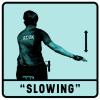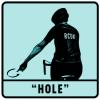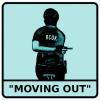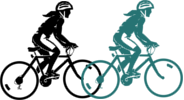Introduction
The club tries to organise safe and enjoyable rides but it cannot be responsible for all road and traffic conditions. Ultimately all riders are responsible for their own safety and should ride accordingly. Do not blindly follow what others are doing if you are not comfortable with it;
A cycle is recognised by law as a vehicle. A cycle rider therefore has the rights and privileges of road use but also has all the responsibilities. Be aware of the requirements and advice given in the Highway Code.
Why ride in a group?
First and foremost - for companionship.
Second - for mutual support. Here's how it works ...
Suppose you are riding at 15 mph on a nice flat road on a nice still day. Another rider goes past you at 17 mph. What do you do?
- If you follow along several metres behind you will need to produce a lot more power, maybe 175 watts rather than 120 watts.
- If you follow 1 metre behind the other rider your air resistance will be greatly reduced. You can stick with your 120 watts but now you too are doing 17 mph! How's that for mutual support!
When riding, keep an eye on what is going on behind you. If you see a rider dropping back, slow down until they reach you and "offer a wheel". If you are that slower rider then accept the offer. Ride behind but slightly to one side of the faster rider with about a one wheel gap (as you gain experience you may be happy being closer). Call out if you want the pace faster or slower. If all goes well you will find yourself gradually rejoining the rest of the group.
This is called "drafting". The professionals do it all the time but it's not just for them! There are some things to bear in mind though:
- Ride smoothly - no sudden changes in pace. Be especially careful when standing up on the pedals as this briefly slows your bike moving it closer to any following rider.
- The benefit of drafting is increased by a headwind. Everyone benefits from taking turns on the front in this situation. Stronger riders should take longer turns.
- The drafting effect reduces as speed slows - so it is less beneficial when going up hill. There is still a psychological benefit from sitting behind another rider though, so the strongest can still help the rest.
Riding along
We can ride along in one line - "singled out" - or in pairs. Never ride three abreast!
Some drivers seem under the impression that riding in pairs is illegal - it isn't. Riding in pairs has several benefits:
- It can make it easier for a car to overtake - less road space is needed to overtake 3 pairs of cyclists than for a long string of 6;
- It can promote safer overtaking - drivers have to make a definite overtaking manoeuvre rather than assuming they can just squeeze through;
- It makes conversation easier!
See Chris Boardman's take on this.
It's not easy to decide when riding in pairs is a good choice. As a rule of thumb, if the road is wide enough to have a white line down the middle it's wide enough for riding in pairs. It can also work on narrower roads which are quiet with good sight lines - but be prepared to single out if a car approaches, the road narrows or when approaching a blind bend.
Not everyone is happy with riding in pairs, especially on the outside. If this applies to you then don't feel obliged to pair up.
Whether you are riding in pairs or singled out try to maintain a compact group. This not only helps with drafting it makes it easier for cars to overtake and for the ride leader to communicate with the group. However ...
Do not overlap wheels!
The rider in front will not know you are there. If they move across you there will be a clash of wheels and a very good chance that both of you will crash.
Pay attention!
It is easy to get deep in conversation following the wheels in front and forgetting to keep a proper lookout. It is your responsibility to watch out for hazards and anticipate problems. Don't rely on others to do this for you.
Stopping
If the group must stop - perhaps for a puncture or to re-group - find somewhere safe to do it. For preference, get off the road. If that is not possible then avoid hazardous places. For example, stop well back from junctions.
Hand Signals
These signals are important as the road ahead may be obscured by other riders. When a rider ahead of you makes one of these signals repeat it immediately - don't wait until you can see the hazard yourself.

Turning right/left.


If it's a sudden stop shout "stopping!".


Tell riders you are about to move out/in to avoid an obstruction such as a parked car or pedestrian.
Calling out
Car ahead! (or Car front!), Car back! (or Car behind!)
These tell other riders that there are cars (or other vehicles) approaching. [The traditional terms are "car up" and "car down". Don't use these! One third of cyclists think "car up" means "car ahead", another third think it means "car behind", the rest cannot remember what it means!]
Slowing! Stopping!
Use these if you are braking quickly and using the hand-signal is impractical or too slow.
Hole!
Shout out for holes when there is not enough time to use the hand signal.
Gravel!
Loose stuff on the road surface.
Single! or Single out!
Experienced riders should use this when they think it is dangerous or obstructive for the group to ride in pairs. You should do it!
Slower! or Easy!
Riders are being dropped so those in front should reduce the pace.
All on! or All together!
The group is back together - no more gaps.
On your wheel! or Behind you!
Tell the rider ahead of you that you have joined them and are riding immediately behind them. They need to be aware of this.
On your left! On your right!
Tell the rider ahead that you are about to move up alongside them. Never move up on the left without giving a warning.
Clear
This is used to indicate that a junction is clear and safe to cross. The use of this is not advised since getting it wrong could be fatal. If a rider ahead of you shouts "clear" you should still check for yourself before going ahead.
Dealing with cars
Everyone has a right to ride a bike on the road and we shouldn't feel we need to apologise for doing it. However, we are slow compared to cars and lorries so we should make a reasonable effort to let them pass.
When someone shouts "car back" you should think about what you can do to help the vehicle pass the group. For example:
- If you are riding in a pair you might tighten up a bit so you take up less road width. You might decide to single out but there is no point in doing this if the road is wide enough for the vehicle to pass you as a pair.
- Close up to the rider in front. A compact group is easier to pass than a long straggle of riders.
- A long line of cyclists can be difficult for a car to overtake. If you are in the middle of the line and you know there is a car behind, slow down and leave a gap so that the driver can overtake in two hops. Be aware that a rider in front of you may do this - don't pass them and fill the gap they are trying to leave!
- On a long, narrow lane it may be necessary for the group to stop to let a vehicle pass.
Do not wave cars past the group. You have no idea what riders ahead of you might be about to do, hence no idea whether it is safe for the car to pass.





